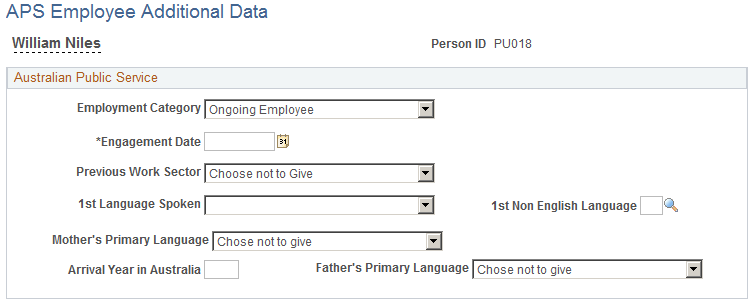Creating Reports for the PSMPC
These topics provide an overview of and discuss Australian PSMPC reporting.
|
Page Name |
Definition Name |
Usage |
|---|---|---|
|
APS_PERSDTA_AUS |
Enter additional employee data required for APS (Australian Public Service) reporting. |
|
|
Define APS Movement Page |
APS_MOVECODE_AUS |
Define or modify codes for changes in employment status. These codes are used by APS for administering human resources functions when employees change positions or job status. |
|
Define APS Non-English Code Page |
APS_LNG_CD_AUS |
Define or modify codes for languages used in APS (Australian Public Service non-English code) reporting. |
|
APS_RUNCTL_AUS |
Process the Snapshot and Change reports for PSMPC (Public Service and Merit Protection Commission) reporting. |
The Australian PSMPC requires that all government agencies provide employment details for employees employed under the Public Service Act 1999. Agencies are required to supply this information to the PSMPC in two files that include a range of personal and employment data about the agency's workforce.
The first file, called the Snapshot report, describes the state of the agency at a particular point in time. The second file, the Change report, describes how the agency has changed over a specific period of time.
The reports supply the employees' current job details. If an employee performs another job for a period of more than 90 consecutive days, then the employee's substantive job is not reported.
Use the APS Employee Additional Data (Australian Public Service employee additional data) page (APS_PERSDTA_AUS) to enter additional employee data required for APS reporting.
Navigation
Image: APS Employee Additional Data page
This example illustrates the fields and controls on the APS Employee Additional Data page. You can find definitions for the fields and controls later on this page.

|
Field or Control |
Definition |
|---|---|
| Employment Category |
Select the appropriate category to define the employee's position. Options are Non Ongoing - Irregular Duties, Non Ongoing - Specific Task, Non Ongoing - Specific Term, and Ongoing Employee. |
| Engagement Date |
Select the date to record the engagement date of the current period of employment in APS. |
| Previous Work Sector |
Select the employee's previous work sector. |
| 1st Language Spoken |
Select the language classification. |
| 1st Non English Language |
If you select Language other than English as the first spoken language, select the employee's first language in this field. |
| Mother's Primary Language andFather's Primary Language |
Select the employee's parents' primary language. |
| Arrival Year in Australia |
Enter the year the employee first arrived in Australia. |
Use the Create APS PSMPC (create Australian Public Service Public Service and Merit Protection Commission) page (APS_RUNCTL_AUS) to process the Snapshot and Change reports for PSMPC reporting.
Navigation
Image: Create APS PSMPC page
This example illustrates the fields and controls on the Create APS PSMPC page. You can find definitions for the fields and controls later on this page.

|
Field or Control |
Definition |
|---|---|
| Company |
Enter the company that you want to report on. |
| Start Date andEnd Date |
This date range is the period when employee details are processed. For the Change report, this date range is the period when change entities specified by APS, like maternity leave or postal code, has changed on the period specified on the run control. For the Snapshot report, employees who are active at the end date will be reported. |
| Report Type |
Select the report type. Options are Change Extract and Snapshot Report. |
| Contact Phone |
Enter a number for the APS employment database project team to call in order to clarify information in the APS employee report. |
See the product documentation for PeopleTools: Process Scheduler